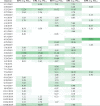Air pollution exposure assessment at schools and playgrounds in Williamsburg Brooklyn NYC, with a view to developing a set of policy solutions
- PMID: 35910306
- PMCID: PMC9321294
- DOI: 10.1007/s13412-022-00777-7
Air pollution exposure assessment at schools and playgrounds in Williamsburg Brooklyn NYC, with a view to developing a set of policy solutions
Abstract
Community science offers unique opportunities for non-professional involvement of volunteers in the scientific process, not just during the data acquisition, but also in other phases, like problem definition, quality assurance, data analysis and interpretation, and the dissemination of results. Moreover, community science can be a powerful tool for public engagement and empowerment during policy formulation. This paper aims to present a pilot study on personal exposure to fine particulate matter (PM2.5) and raises awareness of the hazards of air pollution. As part of data acquisition conducted in 2019, high school students gathered data at their schools, schoolyards, and playgrounds using low-cost monitors AirBeam2. The data was automatically uploaded every second onto the AirCasting mobile app. Besides, a stationary network of air monitors (fixed stations) was deployed in the neighborhood to collect real-time ambient air concentrations of PM2.5. Students involved in the project attended workshops, training sessions, and researched to better understand air pollution, as part of their science class curriculum and portfolio. This air quality monitoring was incorporated into the "Our Air/Nuestro Aire" - El Puente grassroots campaign. The main goals of this campaign included sharing the data collected with the community, engaging academic partners to develop a set of policy and urban design solutions, and to be considered into a 5-point policy platform.
Keywords: Air quality; Community science; Grassroots campaign; PM2.5; Policy solutions; Science class curriculum.
© AESS 2022, Springer Nature or its licensor holds exclusive rights to this article under a publishing agreement with the author(s) or other rightsholder(s); author self-archiving of the accepted manuscript version of this article is solely governed by the terms of such publishing agreement and applicable law.
Figures








Similar articles
-
Personal and ambient exposures to air toxics in Camden, New Jersey.Res Rep Health Eff Inst. 2011 Aug;(160):3-127; discussion 129-51. Res Rep Health Eff Inst. 2011. PMID: 22097188
-
Towards participatory air pollution exposure assessment in a goods movement community.Prog Community Health Partnersh. 2014 Autumn;8(3):291-304. doi: 10.1353/cpr.2014.0047. Prog Community Health Partnersh. 2014. PMID: 25435556
-
A Dynamic Three-Dimensional Air Pollution Exposure Model for Hong Kong.Res Rep Health Eff Inst. 2018 Feb;2018(194):1-65. Res Rep Health Eff Inst. 2018. PMID: 31883241 Free PMC article.
-
Assessing Adverse Health Effects of Long-Term Exposure to Low Levels of Ambient Air Pollution: Implementation of Causal Inference Methods.Res Rep Health Eff Inst. 2022 Jan;2022(211):1-56. Res Rep Health Eff Inst. 2022. PMID: 36193708 Free PMC article. Review.
-
Air quality around schools: Part I - A comprehensive literature review across high-income countries.Environ Res. 2021 May;196:110817. doi: 10.1016/j.envres.2021.110817. Epub 2021 Jan 30. Environ Res. 2021. PMID: 33524334 Review.
Cited by
-
A Framework for Interfacing and Partnering with Environmental Justice Communities as a Prelude to Human Health and Hazard Identification in the Vulnerable Census Tracts of Columbus, Ohio.Int J Environ Res Public Health. 2022 Oct 25;19(21):13846. doi: 10.3390/ijerph192113846. Int J Environ Res Public Health. 2022. PMID: 36360728 Free PMC article. Review.
References
-
- Agyeman Julian, Angus Briony. The role of civic environmentalism in the pursuit of sustainable communities. J Environ Plann Manag. 2003;46(3):345–363. doi: 10.1080/0964056032000096901. - DOI
-
- Artiola JF, Pepper IL, Brusseau M, editors. Environmental monitoring and characterization. Burlington, MA: Elsevier Academic Press; 2004.
-
- Barzyk T, Williams R, Kaufman A, Greenberg M, OShea M, Sheridan P, et al (2016) Citizen science air monitoring in the ironbound community. U.S. Environmental Protection Agency EPA/600/R-16/049, Washington, DC
-
- Blevis E (2007) Sustainable interaction design: invention & disposal, renewal & reuse. In CHI ’07: Proceedings of the SIGCHI Conference on Human Factors in Computing Systems. ACM, New York, pp 503–512
LinkOut - more resources
Full Text Sources
Research Materials
